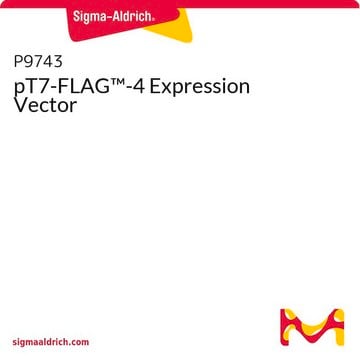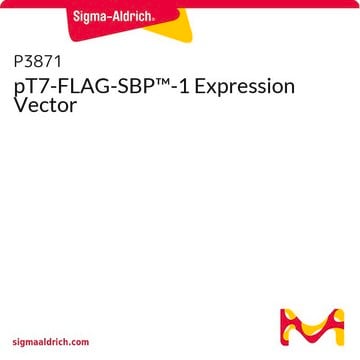P1118
pT7-FLAG™-1 Expression Vector
Iniciar sesiónpara Ver la Fijación de precios por contrato y de la organización
About This Item
Código UNSPSC:
12352200
Productos recomendados
grado
for molecular biology
Formulario
buffered aqueous solution
Condiciones de envío
dry ice
temp. de almacenamiento
−20°C
Descripción general
pT7-FLAG™-2 is a 4.8 kb E . coli expression vector used for cloning and cytoplasmic expression of a properly inserted open reading frame as a N-terminal Met-FLAG fusion protein containing the FLAG® epitope (DYKDDDDK). The promoter region of the very strong phage T7 promoter drives transcription of ORFFLAG fusion constructs. This vector requires the use of E. coli cells containing a source of the T7 polymerase, such as BL21(DE3)T1R cells, Catalog Number B2935.
Aplicación
pT7-FLAG®-1 Expression Vector has been used in the cloning of ubiquitin fusion protein and connexin 43 (Cx43) C-terminal fragment.
Componentes
pT7-FLAG™-1 Expression Vector (P6742) is supplied as 0.5 mg/ml in 10 mM Tris-HCl (pH 8.0) with 1 mM EDTA.
pT7-FLAG™-1-BAP Control Vector (P6992) is supplied as 0.5 mg/ml in 10 mM Tris-HCl (pH 8.0) with 1 mM EDTA.
pT7-FLAG™-1-BAP Control Vector (P6992) is supplied as 0.5 mg/ml in 10 mM Tris-HCl (pH 8.0) with 1 mM EDTA.
Información legal
FLAG is a registered trademark of Merck KGaA, Darmstadt, Germany
pT7-FLAG is a trademark of Sigma-Aldrich Co. LLC
Producto relacionado
Referencia del producto
Descripción
Precios
Código de clase de almacenamiento
12 - Non Combustible Liquids
Elija entre una de las versiones más recientes:
Certificados de análisis (COA)
Lot/Batch Number
¿No ve la versión correcta?
Si necesita una versión concreta, puede buscar un certificado específico por el número de lote.
¿Ya tiene este producto?
Encuentre la documentación para los productos que ha comprado recientemente en la Biblioteca de documentos.
Chase T Archer et al.
The Journal of biological chemistry, 283(31), 21789-21798 (2008-06-03)
Destabilization of activator-DNA complexes by the proteasomal ATPases can inhibit transcription by limiting activator interaction with DNA. Modification of the activator by monoubiquitylation protects the activator from this destabilization activity. In this study, we probe the mechanism of this protective
Yo Sugawara et al.
The Journal of cell biology, 189(4), 691-700 (2010-05-12)
Botulinum neurotoxin is produced by Clostridium botulinum and forms large protein complexes through associations with nontoxic components. We recently found that hemagglutinin (HA), one of the nontoxic components, disrupts the intercellular epithelial barrier; however, the mechanism underlying this phenomenon is
Alasdair I Macdonald et al.
The Biochemical journal, 446(1), 9-21 (2012-06-05)
Gap junctions, composed of Cxs (connexins), allow direct intercellular communication. Gap junctions are often lost during the development of malignancy, although the processes behind this are not fully understood. Cx43 is a widely expressed Cx with a long cytoplasmic C-terminal
Ning Kong et al.
Autophagy, 16(10), 1737-1752 (2019-12-24)
Interferon-induced BST2 (bone marrow stromal cell antigen 2) inhibits viral replication by tethering enveloped virions to the cell surface to restrict viral release and by inducing the NFKB-dependent antiviral immune response. However, the mechanism by which BST2 uses the selective
Nuestro equipo de científicos tiene experiencia en todas las áreas de investigación: Ciencias de la vida, Ciencia de los materiales, Síntesis química, Cromatografía, Analítica y muchas otras.
Póngase en contacto con el Servicio técnico




